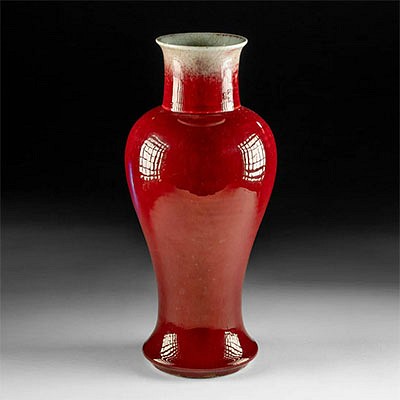Colima Redware Dog Effigy Vessel
Lot 206
About Seller
Artemis Fine Arts
686 S Taylor Ave, Ste 106
Louisville, CO 80027
United States
Selling antiquities, ancient and ethnographic art online since 1993, Artemis Gallery specializes in Classical Antiquities (Egyptian, Greek, Roman, Near Eastern), Asian, Pre-Columbian, African / Tribal / Oceanographic art. Our extensive inventory includes pottery, stone, metal, wood, glass and textil...Read more
Estimate:
$3,000 - $4,500
Absentee vs Live bid
Two ways to bid:
- Leave a max absentee bid and the platform will bid on your behalf up to your maximum bid during the live auction.
- Bid live during the auction and your bids will be submitted real-time to the auctioneer.
Bid Increments
| Price | Bid Increment |
|---|---|
| $0 | $25 |
| $300 | $50 |
| $1,000 | $100 |
| $2,000 | $250 |
| $5,000 | $500 |
| $10,000 | $1,000 |
| $20,000 | $2,500 |
| $50,000 | $5,000 |
| $100,000 | $10,000 |
| $200,000 | $20,000 |
About Auction
By Artemis Fine Arts
May 11, 2023
Set Reminder
2023-05-11 10:00:00
2023-05-11 10:00:00
America/New_York
Bidsquare
Bidsquare : Fine Antiquities, Asian, Pre-Columbian, Ethnographic Art
https://www.bidsquare.com/auctions/artemis-gallery/fine-antiquities-asian-pre-columbian-ethnographic-art-12771
Classical antiquities, ancient and ethnographic art from cultures encompassing the globe. Artemis Fine Arts info@artemisfinearts.com
Classical antiquities, ancient and ethnographic art from cultures encompassing the globe. Artemis Fine Arts info@artemisfinearts.com
- Lot Description
**Originally Listed At $1500**
Pre-Columbian, West Mexico, Colima, ca. 300 BCE to 300 CE. A beautifully constructed, hand-built redware dog vessel of a charming form that exhibits a playful nature and smooth, highly burnished surfaces enveloped in hues of burnt sienna and black. The corpulent canine stands with a portly abdomen atop a quartet of bowed legs and features a raised neck, powerful shoulders, and a perky tail that doubles as the vessel's spout. The conical head protrudes out from the neck and bears incised, almond-shaped eyes, a tapered snout with carved-out nostrils, an incised mouth, and a large pair of perky ears flanking the rounded skull cap. Size: 16.9" L x 7.6" W x 9.6" H (42.9 cm x 19.3 cm x 24.4 cm)
Pottery canines like this one are the only remains that we have today of a sophisticated and unique culture in West Mexico - they made no above-ground monuments or sculptures, at least that we know of, which is in strong contrast to developments elsewhere in ancient Mesoamerica. Instead, their tombs were their lasting works of art: skeletons arrayed radially with their feet positioned inward, and clay offerings, like this example, placed alongside the walls facing inward, near the skulls. A large effigy like this one most likely would have flanked the entrance to a tomb in a way that archaeologists have interpreted as guarding. Some scholars have interpreted these dynamic sculptures of the living as a strong contrast to the skeletal remains whose space they shared, as if they mediated between the living and the dead.
Scholars know of at least two types of Colima dogs, one to be fattened up and ritually sacrificed or eaten and one to serve as a watchdog and healer of the ill. This plump hairless canine known as a Chichi or Escuintla is thought to be related to the Chihuahua or Mexican Hairless also known as the Xoloitzcuintle. The Xolo dog was named for the deity Xolotl, the God of the Underworld, and believed to guide the deceased as they journeyed to the afterlife. Colima vessels like this example were buried in shaft tombs to protect the deceased and provide sustenance for eternity.
Provenance: private Marietta, Georgia, USA collection; ex-Ed Holshuh, acquired in Manzanillo, Mexico in the early 1960s
All items legal to buy/sell under U.S. Statute covering cultural patrimony Code 2600, CHAPTER 14, and are guaranteed to be as described or your money back.
A Certificate of Authenticity will accompany all winning bids.
We ship worldwide and handle all shipping in-house for your convenience.
#178005Professionally repaired and restored with some repainting and infill at break lines. Chipping to proper left ear, as well expected nicks and abrasions to surface, all commensurate with age. Otherwise, very nice with rich mineral deposits.Condition
- Shipping Info
-
All shipping is handled in-house for your convenience. Your invoice from Artemis Gallery will include shipping calculation instructions. If in doubt, please inquire BEFORE bidding for estimated shipping costs for individual items. In most cases Artemis Gallery cannot ship to Australia and Germany, please inquire before bidding.
-
- Buyer's Premium



 EUR
EUR CAD
CAD AUD
AUD GBP
GBP MXN
MXN HKD
HKD CNY
CNY MYR
MYR SEK
SEK SGD
SGD CHF
CHF THB
THB














